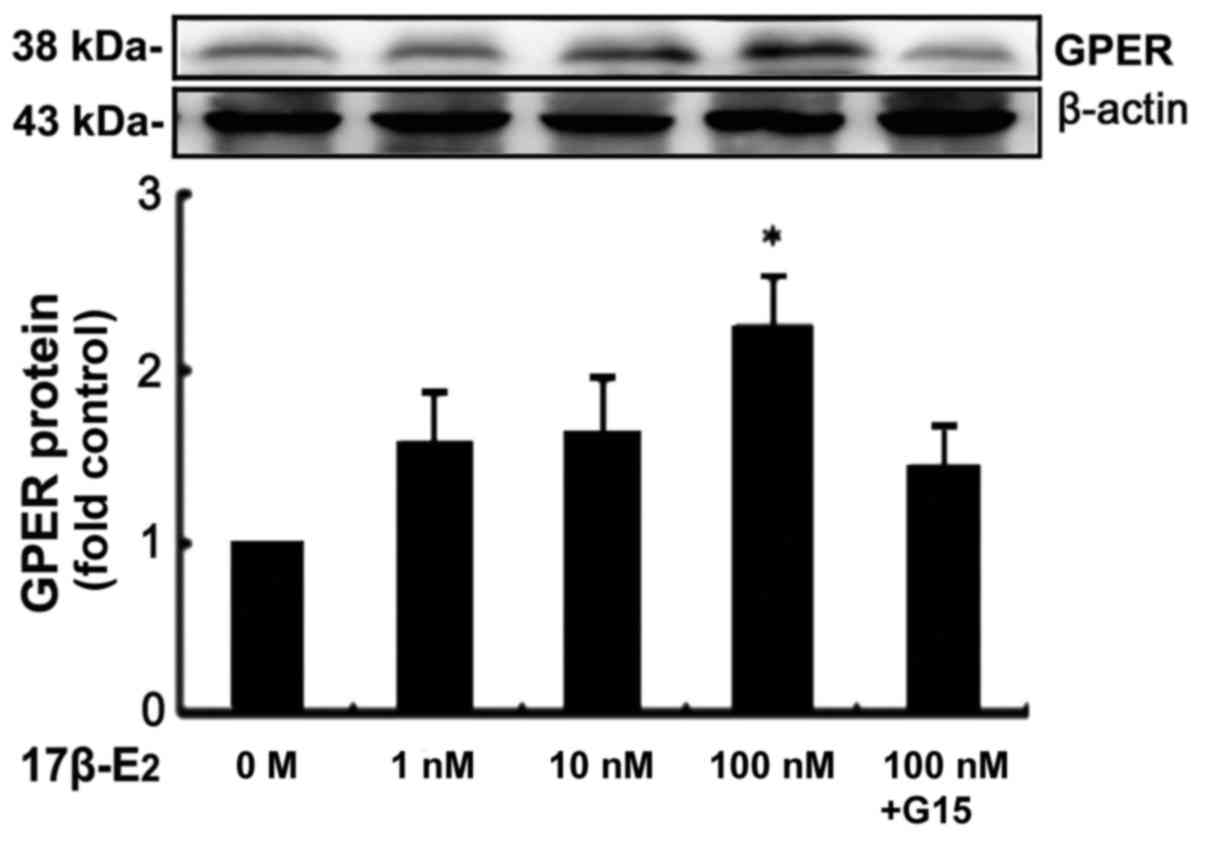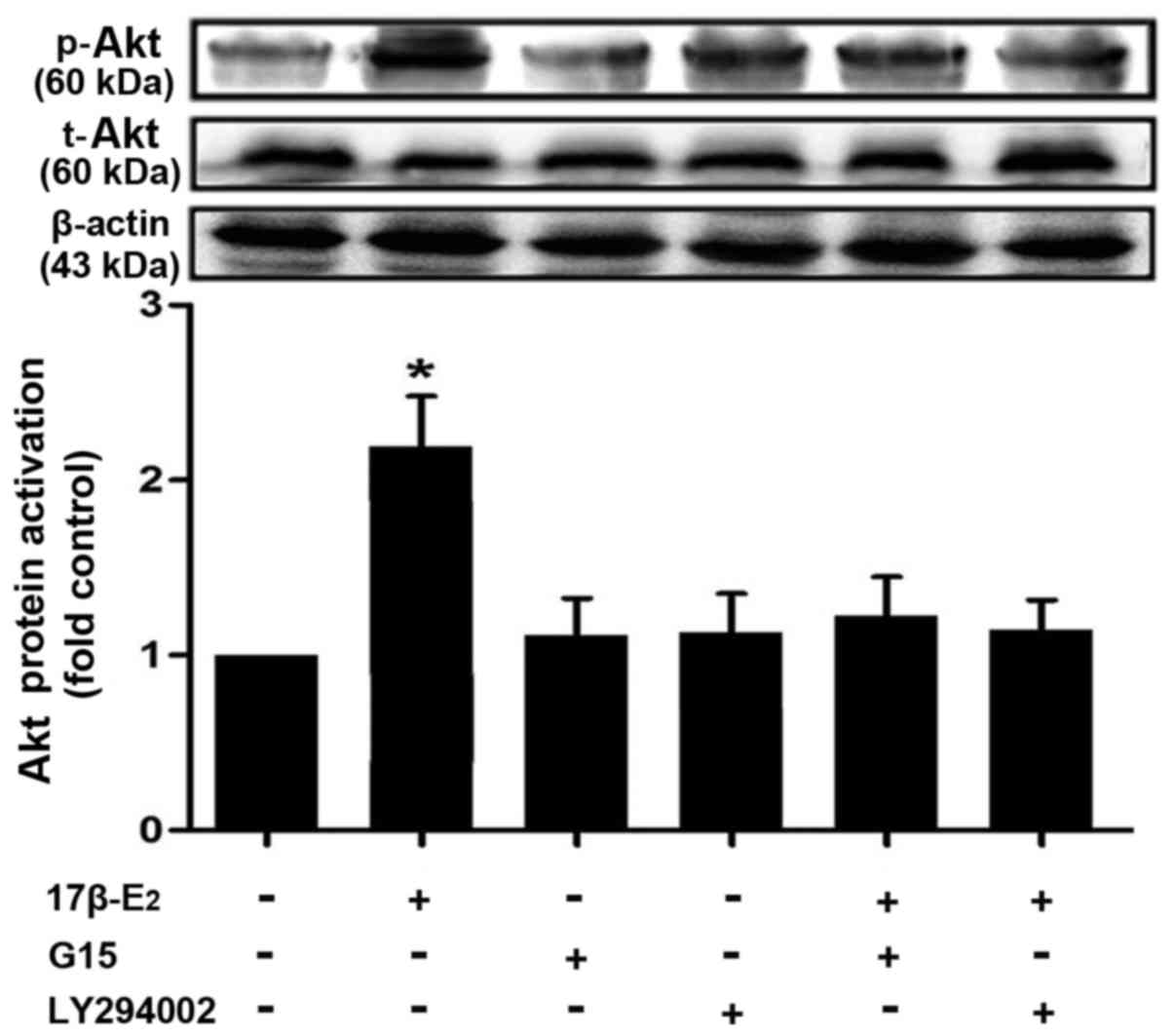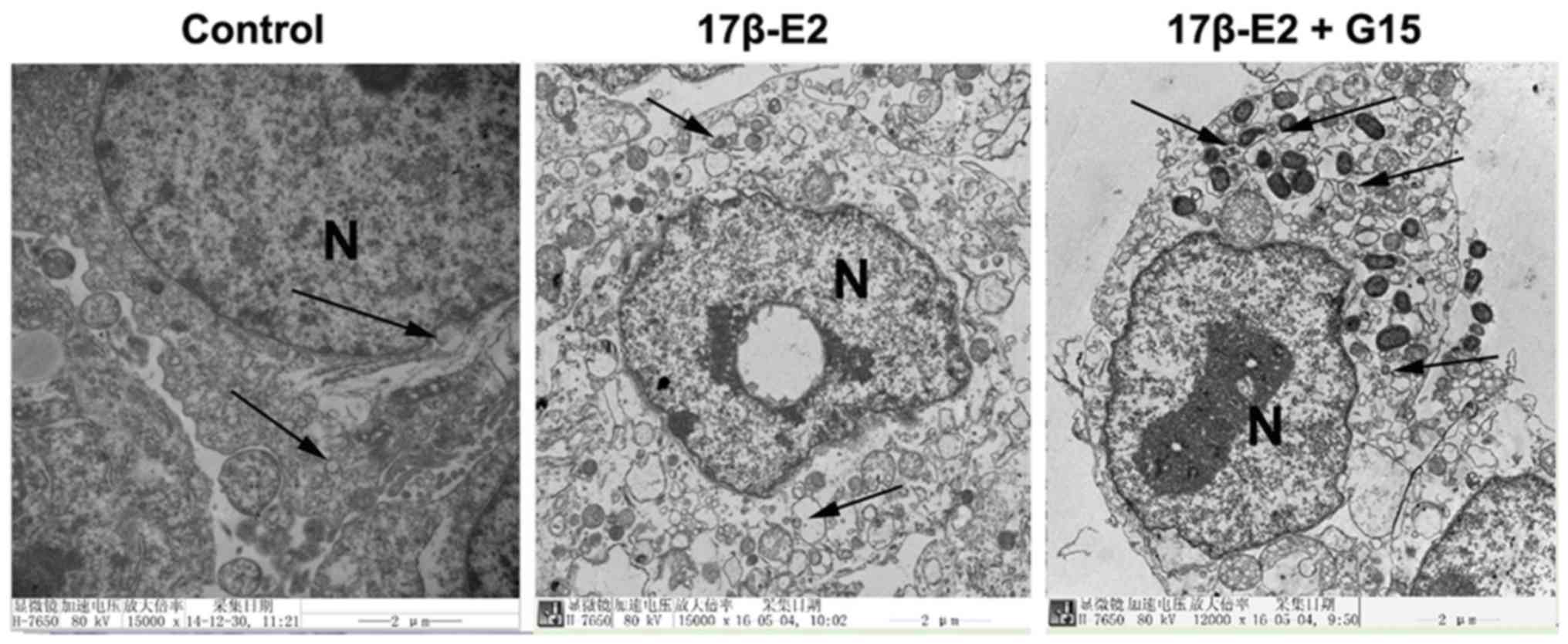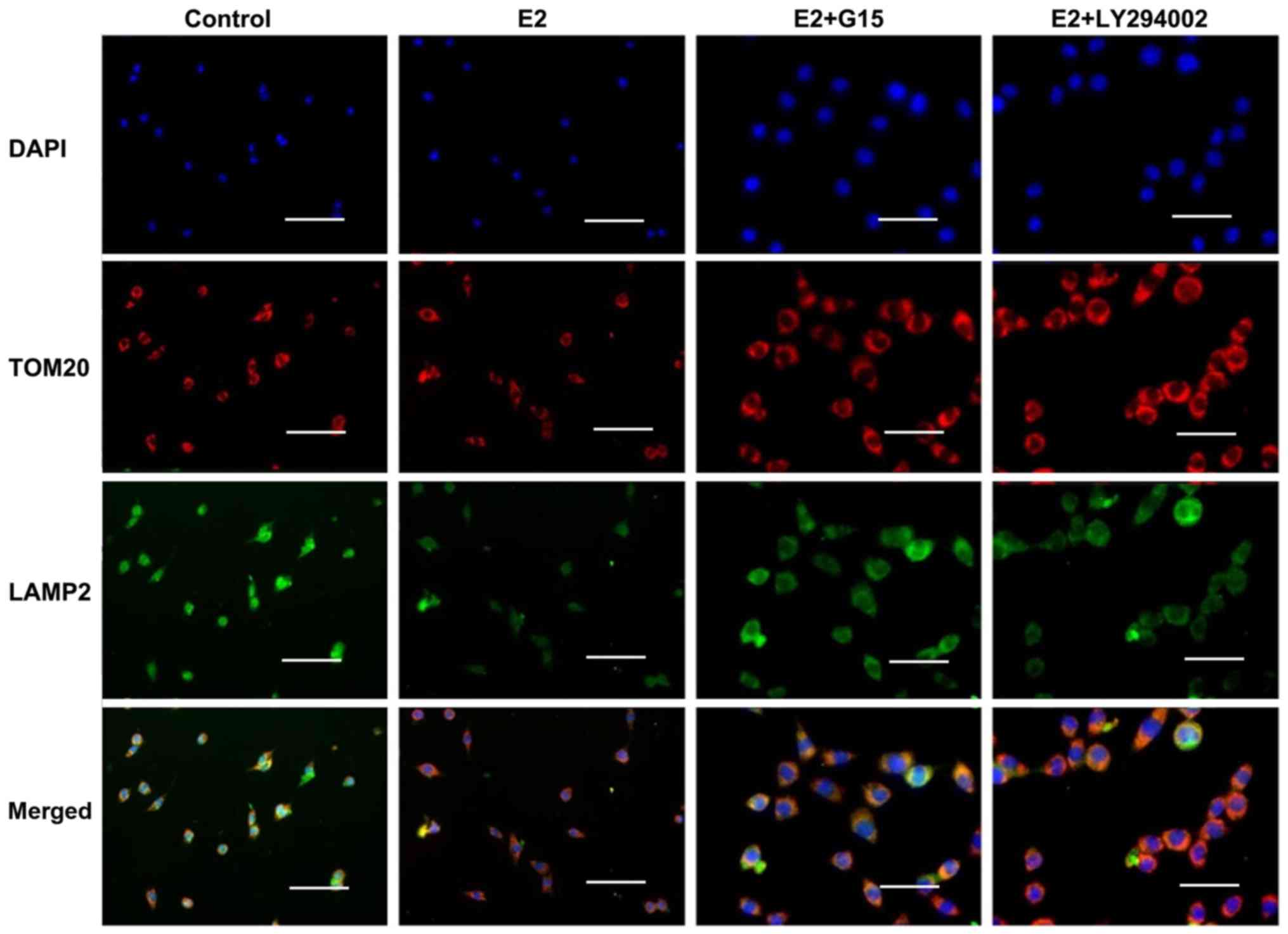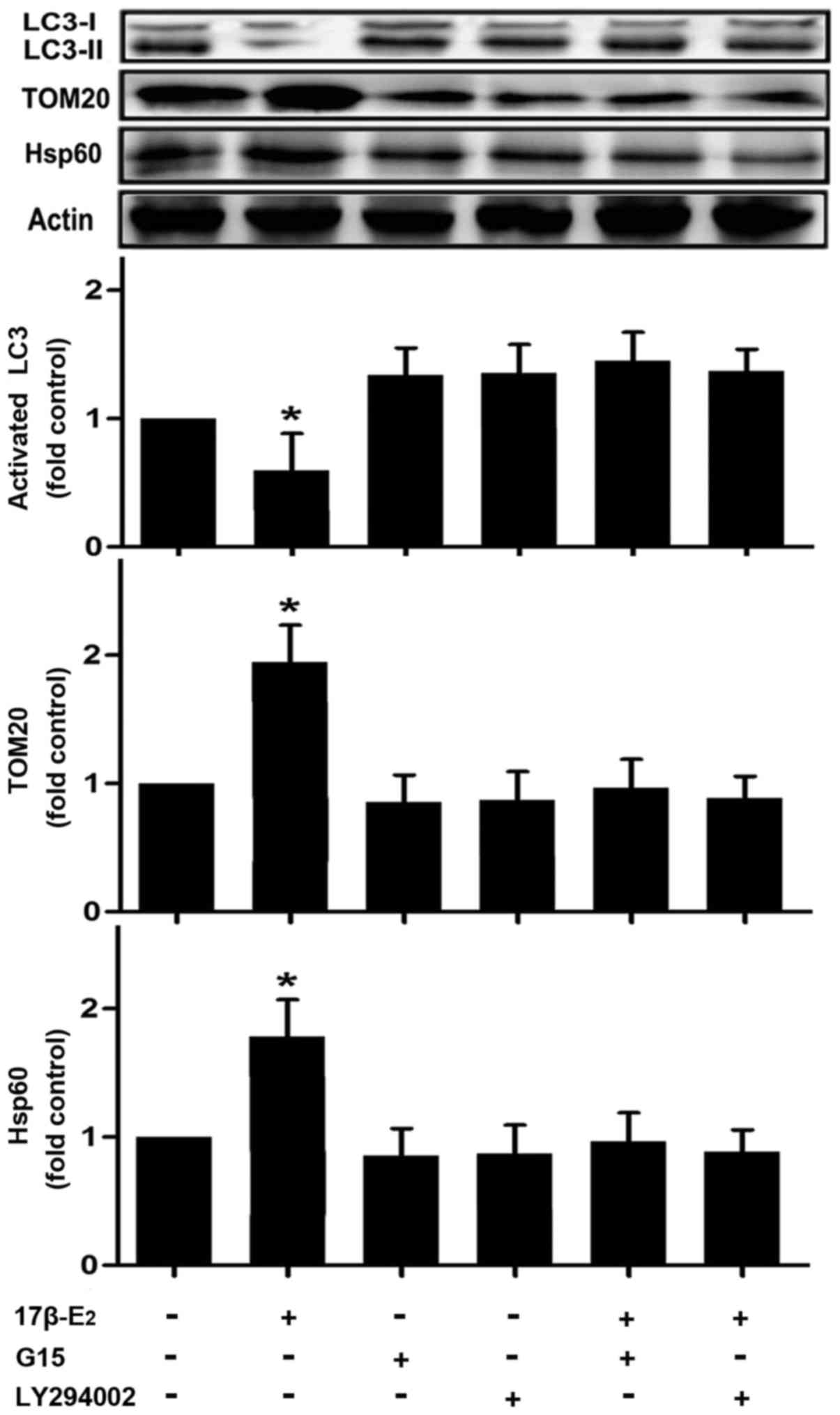|
1
|
Kahn SE, Zraika S, Utzschneider KM and
Hull RL: The beta cell lesion in type 2 diabetes: There has to be a
primary functional abnormality. Diabetologia. 52:1003–1012. 2009.
View Article : Google Scholar : PubMed/NCBI
|
|
2
|
Marchetti P, Dotta F, Lauro D and Purrello
F: An overview of pancreatic beta-cell defects in human type 2
diabetes: Implications for treatment. Regul Pept. 146:4–11. 2008.
View Article : Google Scholar
|
|
3
|
Prentki M and Nolan CJ: Islet beta cell
failure in type 2 diabetes. J Clin Invest. 116:1802–1812. 2006.
View Article : Google Scholar : PubMed/NCBI
|
|
4
|
Geisler JG, Zawalich W, Zawalich K, Lakey
JR, Stukenbrok H, Milici AJ and Soeller WC: Estrogen can prevent or
reverse obesity and diabetes in mice expressing human islet amyloid
polypeptide. Diabetes. 51:2158–2169. 2002. View Article : Google Scholar : PubMed/NCBI
|
|
5
|
Nadal A, Ropero AB, Laribi O, Maillet M,
Fuentes E and Soria B: Nongenomic actions of estrogens and
xenoestrogens by binding at a plasma membrane receptor unrelated to
estrogen receptor alpha and estrogen receptor beta. Proc Natl Acad
Sci USA. 97:11603–11608. 2000. View Article : Google Scholar : PubMed/NCBI
|
|
6
|
Ropero AB, Soria B and Nadal A: A
nonclassical estrogen membrane receptor triggers rapid differential
actions in the endocrine pancreas. Mol Endocrinol. 16:497–505.
2002. View Article : Google Scholar : PubMed/NCBI
|
|
7
|
Mårtensson UE, Salehi SA, Windahl S, Gomez
MF, Swärd K, Daszkiewicz-Nilsson J, Wendt A, Andersson N,
Hellstrand P, Grände PO, et al: Deletion of the G protein-coupled
receptor 30 impairs glucose tolerance, reduces bone growth,
increases blood pressure, and eliminates estradiol-stimulated
insulin release in female mice. Endocrinology. 150:687–698. 2009.
View Article : Google Scholar
|
|
8
|
Sharma G and Prossnitz ER: Mechanisms of
estradiol-induced insulin secretion by the G protein-coupled
estrogen receptor GPR30/GPER in pancreatic beta-cells.
Endocrinology. 152:3030–3039. 2011. View Article : Google Scholar : PubMed/NCBI
|
|
9
|
Ropero AB, Pang Y, Alonso-Magdalena P,
Thomas P and Nadal A: Role of ERβ and GPR30 in the endocrine
pancreas: A matter of estrogen dose. Steroids. 77:951–958. 2012.
View Article : Google Scholar : PubMed/NCBI
|
|
10
|
Alexander SP, Davenport AP, Kelly E,
Marrion N, Peters JA, Benson HE, Faccenda E, Pawson AJ, Sharman JL,
Southan C, et al: CGTP Collaborators: The Concise Guide to
PHARMACOLOGY 2015/16: G protein-coupled receptors. Br J Pharmacol.
172:5744–5869. 2015. View Article : Google Scholar : PubMed/NCBI
|
|
11
|
Revankar CM, Cimino DF, Sklar LA,
Arterburn JB and Prossnitz ER: A transmembrane intracellular
estrogen receptor mediates rapid cell signaling. Science.
307:1625–1630. 2005. View Article : Google Scholar : PubMed/NCBI
|
|
12
|
Prossnitz ER and Barton M: The
G-protein-coupled estrogen receptor GPER in health and disease. Nat
Rev Endocrinol. 7:715–726. 2011. View Article : Google Scholar : PubMed/NCBI
|
|
13
|
Suire S, Condliffe AM, Ferguson GJ, Ellson
CD, Guillou H, Davidson K, Welch H, Coadwell J, Turner M, Chilvers
ER, et al: Gbetagammas and the Ras binding domain of p110gamma are
both important regulators of PI(3)Kgamma signalling in neutrophils.
Nat Cell Biol. 8:1303–1309. 2006. View
Article : Google Scholar : PubMed/NCBI
|
|
14
|
Dbouk HA, Vadas O, Shymanets A, Burke JE,
Salamon RS, Khalil BD, Barrett MO, Waldo GL, Surve C, Hsueh C, et
al: G protein-coupled receptor-mediated activation of p110β by Gβγ
is required for cellular transformation and invasiveness. Sci
Signal. 5:ra892012. View Article : Google Scholar
|
|
15
|
Durand CA, Hartvigsen K, Fogelstrand L,
Kim S, Iritani S, Vanhaesebroeck B, Witztum JL, Puri KD and Gold
MR: Phosphoinositide 3-kinase p110 delta regulates natural antibody
production, marginal zone and B-1 B cell function, and autoantibody
responses. J Immunol. 183:5673–5684. 2009. View Article : Google Scholar : PubMed/NCBI
|
|
16
|
De Duve C and Wattiaux R: Functions of
lysosomes. Annu Rev Physiol. 28:435–492. 1966. View Article : Google Scholar : PubMed/NCBI
|
|
17
|
Clark SL Jr: Cellular differentiation in
the kidneys of newborn mice studies with the electron microscope. J
Biophys Biochem Cytol. 3:349–362. 1957. View Article : Google Scholar : PubMed/NCBI
|
|
18
|
Choi AM, Ryter SW and Levine B: Autophagy
in human health and disease. N Engl J Med. 368:1845–1846. 2013.
View Article : Google Scholar : PubMed/NCBI
|
|
19
|
Janku F, McConkey DJ, Hong DS and Kurzrock
R: Autophagy as a target for anticancer therapy. Nat Rev Clin
Oncol. 8:528–539. 2011. View Article : Google Scholar : PubMed/NCBI
|
|
20
|
Carayol N, Vakana E, Sassano A, Kaur S,
Goussetis DJ, Glaser H, Druker BJ, Donato NJ, Altman JK, Barr S, et
al: Critical roles for mTORC2- and rapamycin-insensitive
mTORC1-complexes in growth and survival of BCR-ABL-expressing
leukemic cells. Proc Natl Acad Sci USA. 107:12469–12474. 2010.
View Article : Google Scholar : PubMed/NCBI
|
|
21
|
Fan QW, Cheng C, Hackett C, Feldman M,
Houseman BT, Nicolaides T, Haas-Kogan D, James CD, Oakes SA,
Debnath J, et al: Akt and autophagy cooperate to promote survival
of drug-resistant glioma. Sci Signal. 3:ra812010. View Article : Google Scholar : PubMed/NCBI
|
|
22
|
Lemasters JJ: Selective mitochondrial
autophagy, or mitophagy, as a targeted defense against oxidative
stress, mitochondrial dysfunction, and aging. Rejuvenation Res.
8:3–5. 2005. View Article : Google Scholar : PubMed/NCBI
|
|
23
|
Mitchell T, Chacko B, Ballinger SW, Bailey
SM, Zhang J and Darley-Usmar V: Convergent mechanisms for
dysregulation of mitochondrial quality control in metabolic
disease: Implications for mitochondrial therapeutics. Biochem Soc
Trans. 41:127–133. 2013. View Article : Google Scholar : PubMed/NCBI
|
|
24
|
Andersson SG, Zomorodipour A, Andersson
JO, Sicheritz-Pontén T, Alsmark UC, Podowski RM, Näslund AK,
Eriksson AS, Winkler HH and Kurland CG: The genome sequence of
Rickettsia prowazekii and the origin of mitochondria. Nature.
396:133–140. 1998. View
Article : Google Scholar : PubMed/NCBI
|
|
25
|
Kim I and Lemasters JJ: Mitochondrial
degradation by autophagy (mitophagy) in GFP-LC3 transgenic
hepatocytes during nutrient deprivation. Am J Physiol Cell Physiol.
300:C308–C317. 2011. View Article : Google Scholar :
|
|
26
|
Twig G and Shirihai OS: The interplay
between mitochondrial dynamics and mitophagy. Antioxid Redox
Signal. 14:1939–1951. 2011. View Article : Google Scholar :
|
|
27
|
Sastre-Serra J, Nadal-Serrano M, Pons DG,
Roca P and Oliver J: Mitochondrial dynamics is affected by
17β-estradiol in the MCF-7 breast cancer cell line. Effects on
fusion and fission related genes. Int J Biochem Cell Biol.
44:1901–1905. 2012. View Article : Google Scholar : PubMed/NCBI
|
|
28
|
Zhang J: Teaching the basics of autophagy
and mitophagy to redox biologists - mechanisms and experimental
approaches. Redox Biol. 4:242–259. 2015. View Article : Google Scholar
|
|
29
|
Kabeya Y, Mizushima N, Ueno T, Yamamoto A,
Kirisako T, Noda T, Kominami E, Ohsumi Y and Yoshimori T: LC3, a
mammalian homologue of yeast Apg8p, is localized in autophagosome
membranes after processing. EMBO J. 19:5720–5728. 2000. View Article : Google Scholar : PubMed/NCBI
|
|
30
|
Chang F, Lee JT, Navolanic PM, Steelman
LS, Shelton JG, Blalock WL, Franklin RA and McCubrey JA:
Involvement of PI3K/Akt pathway in cell cycle progression,
apoptosis, and neoplastic transformation: A target for cancer
chemotherapy. Leukemia. 17:590–603. 2003. View Article : Google Scholar : PubMed/NCBI
|
|
31
|
Manning BD and Cantley LC: AKT/PKB
signaling: Navigating downstream. Cell. 129:1261–1274. 2007.
View Article : Google Scholar : PubMed/NCBI
|
|
32
|
Brazil DP, Yang ZZ and Hemmings BA:
Advances in protein kinase B signalling: AKTion on multiple fronts.
Trends Biochem Sci. 29:233–242. 2004. View Article : Google Scholar : PubMed/NCBI
|
|
33
|
Lee TM, Lin SZ and Chang NC: Both GPER and
membrane oestrogen receptor-α activation protect ventricular
remodelling in 17β oestradiol-treated ovariectomized infarcted
rats. J Cell Mol Med. 18:2454–2465. 2014. View Article : Google Scholar : PubMed/NCBI
|
|
34
|
Vivacqua A, De Marco P, Santolla MF,
Cirillo F, Pellegrino M, Panno ML, Abonante S and Maggiolini M:
Estrogenic gper signaling regulates mir144 expression in cancer
cells and cancer-associated fibroblasts (cafs). Oncotarget.
6:16573–16587. 2015. View Article : Google Scholar : PubMed/NCBI
|
|
35
|
Tsai CL, Wu HM, Lin CY, Lin YJ, Chao A,
Wang TH, Hsueh S, Lai CH and Wang HS: Estradiol and tamoxifen
induce cell migration through GPR30 and activation of focal
adhesion kinase (FAK) in endometrial cancers with low or without
nuclear estrogen receptor α (ERα). PLoS One. 8:e729992013.
View Article : Google Scholar
|
|
36
|
Wróbel AM and Gregoraszczuk EL: Action of
methyl-, propyl-and butylparaben on GPR30 gene and protein
expression, cAMP levels and activation of ERK1/2 and PI3K/Akt
signaling pathways in MCF-7 breast cancer cells and MCF-10A
non-transformed breast epithelial cells. Toxicol Lett. 238:110–116.
2015. View Article : Google Scholar
|
|
37
|
Stiles L and Shirihai OS: Mitochondrial
dynamics and morphology in beta-cells. Best Pract Res Clin
Endocrinol Metab. 26:725–738. 2012. View Article : Google Scholar : PubMed/NCBI
|
|
38
|
Sribnick EA, Matzelle DD, Ray SK and Banik
NL: Estrogen treatment of spinal cord injury attenuates calpain
activation and apoptosis. J Neurosci Res. 84:1064–1075. 2006.
View Article : Google Scholar : PubMed/NCBI
|
|
39
|
Jiang H, Zhang J, Zhu H, Li H and Zhang X:
Nerve growth factor prevents the apoptosis-associated increase in
acetylcholinesterase activity after hydrogen peroxide treatment by
activating Akt. Acta Biochim Biophys Sin (Shanghai). 39:46–56.
2007. View Article : Google Scholar
|
|
40
|
Zhang L, Wang H, Cong Z, Xu J, Zhu J, Ji X
and Ding K: Wogonoside induces autophagy-related apoptosis in human
glioblastoma cells. Oncol Rep. 32:1179–1187. 2014. View Article : Google Scholar : PubMed/NCBI
|
|
41
|
Liu K, Shi Y, Guo XH, Ouyang YB, Wang SS,
Liu DJ, Wang AN, Li N and Chen DX: Phosphorylated AKT inhibits the
apoptosis induced by DRAM-mediated mitophagy in hepatocellular
carcinoma by preventing the translocation of DRAM to mitochondria.
Cell Death Dis. 5:e10782014. View Article : Google Scholar : PubMed/NCBI
|
|
42
|
Ma J, Meng F, Li S, Liu L, Zhao L, Liu Y,
Hu Y, Li Z, Yao Y, Xi Z, et al: Autophagy induction by
endothelial-monocyte activating polypeptide II contributes to the
inhibition of malignant biological behaviors by the combination of
EMAP II with rapamycin in human glioblastoma. Front Mol Neurosci.
8:742015. View Article : Google Scholar : PubMed/NCBI
|
|
43
|
Liu YQ, Ji Y, Li XZ, Tian KL, Young CY,
Lou HX and Yuan HQ: Retigeric acid B-induced mitophagy by oxidative
stress attenuates cell death against prostate cancer cells in
vitro. Acta Pharmacol Sin. 34:1183–1191. 2013. View Article : Google Scholar : PubMed/NCBI
|
|
44
|
Chen G, Ke Z, Xu M, Liao M, Wang X, Qi Y,
Zhang T, Frank JA, Bower KA, Shi X, et al: Autophagy is a
protective response to ethanol neurotoxicity. Autophagy.
8:1577–1589. 2012. View Article : Google Scholar : PubMed/NCBI
|
|
45
|
Zhuang W, Qin Z and Liang Z: The role of
autophagy in sensitizing malignant glioma cells to radiation
therapy. Acta Biochim Biophys Sin (Shanghai). 41:341–351. 2009.
View Article : Google Scholar
|
|
46
|
Edinger AL and Thompson CB: An activated
mTOR mutant supports growth factor-independent, nutrient-dependent
cell survival. Oncogene. 23:5654–5663. 2004. View Article : Google Scholar : PubMed/NCBI
|
|
47
|
O'Sullivan TE, Johnson LR, Kang HH and Sun
JC: BNIP3- and BNIP3L-mediated mitophagy promotes the generation of
natural killer cell memory. Immunity. 43:331–342. 2015. View Article : Google Scholar : PubMed/NCBI
|
















